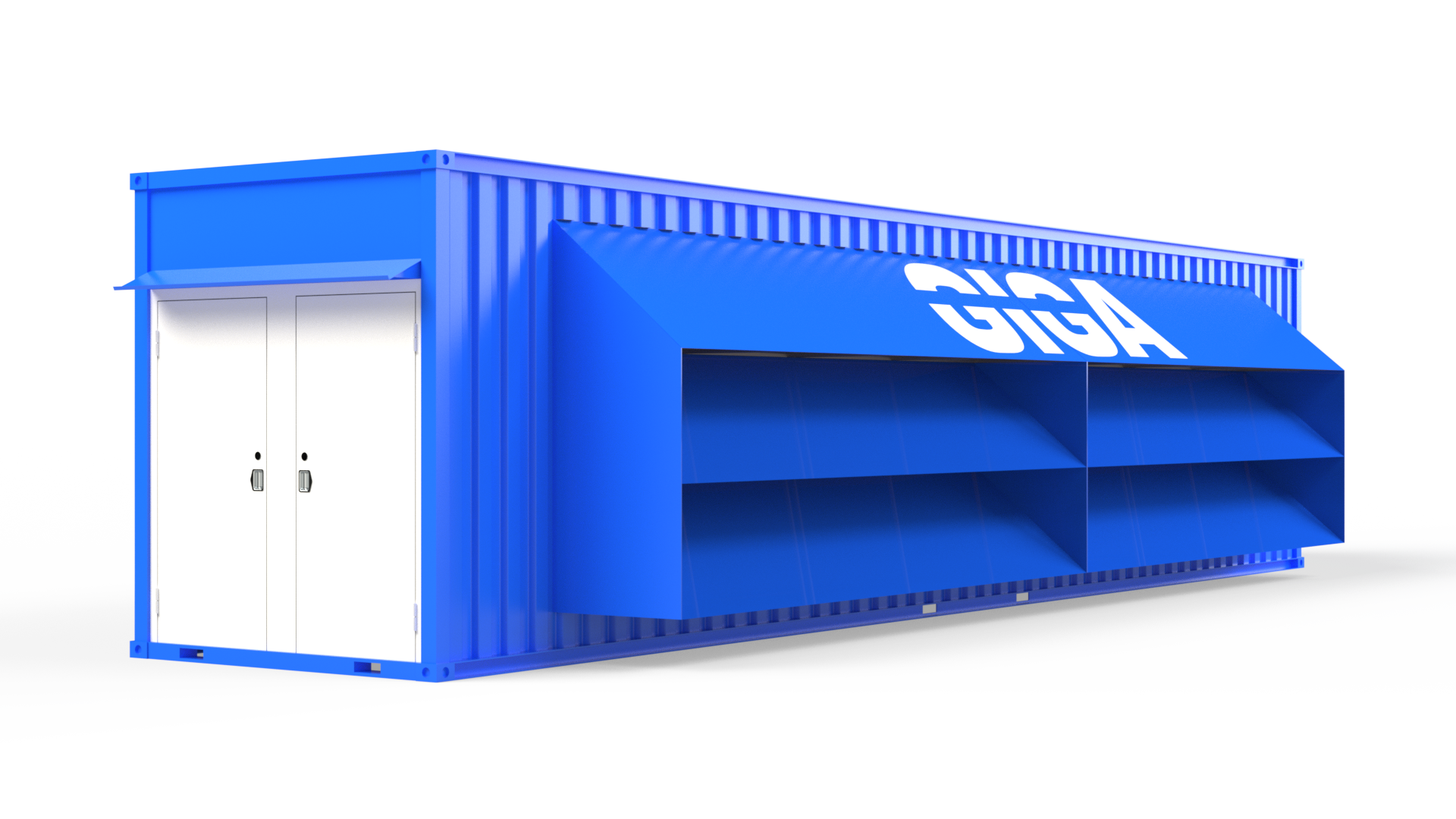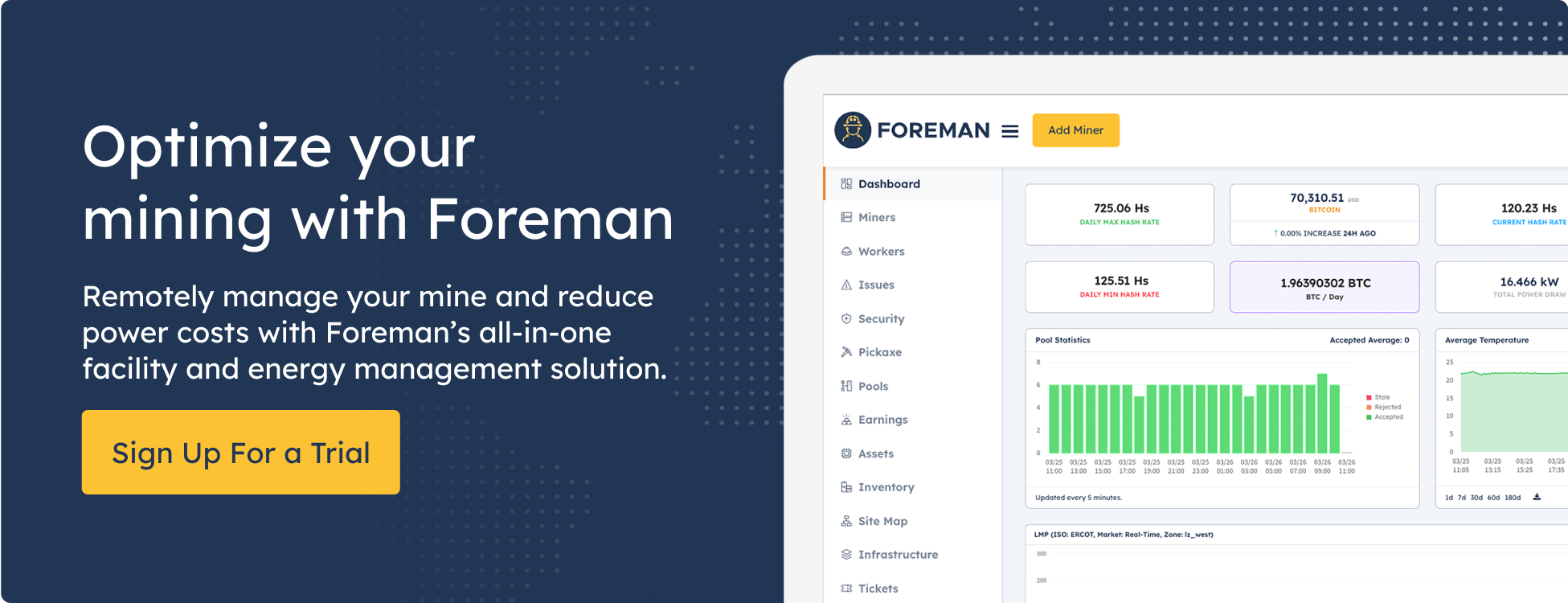Bitcoin mining containers are versatile units that allow miners to deploy mining rigs on almost any site. This solution has become the most accessible for those benefiting from on-site energy arbitrage. The versatility of mining containers has quickly grown into a fast-evolving industry, enabling Bitcoin miner deployment in many shapes and sizes, from large-scale facilities to remote flare gas sites.
Containers have become an unexpendable tool for those seeking low-cost electricity and power arbitrage on-site and in remote locations. Below we’ll go through all the aspects you need to know about a mining container, including types of containers, what to look for, and general pitfalls when purchasing.
Sections:
- Container Types and Sizes
- Remote Management
- Air Intake, Circulation, and Filtration
- Power Distribution
- Rack Style and Miner Type
- Security
- Deployment
Container Types and Sizes
Container types and sizes can vary depending on the application and drop zone. The two application types are specific to the miners you’re deploying: air-cooled or water/immersion-cooled. Container size can range from a few feet to the size of a train car.
Air Cooled
Air-cooled containers are the most common type of mining container. They come in small to large applications and vary depending on power capabilities on site. The size of the site matters when looking into mining containers. If there is a specific output wattage the site is targeting, it’s best to base your container purchase on that. For example, small flaring sites run a small modular data center costing around $20,000 to $40,000. In contrast, larger sites that produce multiple megawatts will likely need multiple 40ft containers ranging to upwards of $200,000.
Immersion
For immersion, applications come in tanks, a few feet wide to larger sizes, and containers filled with immersion. Tanks hold the specific hardware and circulate non-conductive dielectric cooling liquid through the tank to keep the machines at a regulated temperature. Immersion tanks can increase the machine's lifetime and allow users to overclock more efficiently. While Immersion miners have some different features, they require a more complicated setup than air-cooled machines.
Remote Management
Something that is not typically included when purchasing containers is the miner management system. Sure, hardware in the container provides miners power and networking, but remote management is vital to the efficiency of your operation. Foreman provides a management solution for owners to keep a pulse on the miners remotely; all it takes is a small on-site computer.
Miner Management software allows users to monitor their container and the site, visualize if miners have powered down, and keep miners running at maximum capacity. The ticketing system can conserve time and energy by batching issues before sending a technician to the site. Foreman can also integrate and curtail using smart PDUs, auto-generate a site map, and allow easy visibility into the container.
For more information, visit the Foreman information page here.
Air intake, Circulation, and Filtration
Fans:
There are two types of fans for air intake systems.
- On-board miner fans
- External auxiliary fans.
The first type utilizes onboard fans from the machines, with no additional fan to pull air through the container. The miner uses its inboard fans to direct the air through the container, drawing no additional power.
The second type of fan is an auxiliary fan. Large fans are placed inside or outside, pulling the air through the container and sending hot air out. These fans are generally bigger and optimized to make airflow the most efficient. There are usually two types of powering auxiliary fans, with a simple on/off function or with variable frequency drives (VFD). Variable frequency fans are helpful when underclocking/overclocking machines as they allow you to modulate the speed of the fans. This way, the fans can run slower or faster depending on different variables such as ambient temperature or more nuanced chip temps.
Intake
Miner air intake can be either flat with no change in the panel or have an increased surface area in the air intake panel itself. An increase in size or surface area allows the intake to pull much more air in so as not to choke or impede the fans, allowing more air to enter the container to evacuate more heat eventually. That pressure change helps keep hot air from getting sucked back into the miner and causing backdrafts.

Filtration
Air intake is crucial to keeping machines running at optimal levels. When containers are dropped on site, it is worth noting what type of site the container might be used on. Is it going to be snowy and cold or hot and dusty? Does the air intake have a rain cover? All these should be considered for the application of your mining container. Different types of Air filters will help in different situations; it's just about finding the right one for the job.
Power Distribution
PDUs and Smart PDUs
Two types of Power Distribution Units (PDUs) are usually used within a container. Both are for different applications and use cases, depending on how much the user is willing to spend.
A regular PDU is a device that distributes power to multiple devices across the container. They were historically used for data centers and now find a similar use case with bitcoin mining. Mining containers have adapted their rack system utilizing the same hardware.
Smart PDUs offer a range of advanced features that go beyond basic power distribution. They leverage network capabilities to monitor and manage crucial variables like power input and output, ensuring efficient and reliable power delivery. One key enhancement provided by Smart PDUs is phase balancing. These PDUs can distribute power more evenly across multiple phases by employing a three-phase system. This prevents imbalances and helps maintain a consistent and stable power supply to the ASICs (Application-Specific Integrated Circuits) within the mining container. This, in turn, safeguards the quality and reliability of the mining operations by reducing the risk of power fluctuations and associated downtime. In essence, Smart PDUs with phase-balancing capabilities are instrumental in optimizing the performance and longevity of mining containers in cryptocurrency mining operations.
Specifically, in Foreman, users can add ASICs efficiently to a site map. ASICs can also be controlled and monitored more precisely with these tools, showing the direct power draw of the machine with the ability to export reports and data.
Mining Container Power Infrastructure
Everything in your container should be rated for continuous use with an 80% De-rate if the container is in the field or on-site. That means that if there are 30 amp breakers, the max cap is 24 amps. Ensuring the rig is checked by an electrician is essential when understanding the derate and providing things are up to standard.
Checking the wiring and neatness in the container is also a good idea. Practicing proper wire management will keep everything visually neat and accessible within your container. Safety is another concern with power distribution. It’s essential to look for grounding throughout the container, bare wiring at the connection points, and electrical panels with dead fronts to prevent arc flashes. An Arc Flash is a massive electrical explosion, possibly caused by improperly installed, worn, or gapped connections or parts. It is no joke, and having equipment to help protect the workers is something to consider when looking for containers. Any plastic or plexiglass should be avoided.
Rack Style
The racking system is how the miners sit within the container. The rack will decide how much power density the unit has and should be specific to the miner type that is going to be installed. The rack could be set up in order of most to least prevalent in two primary ways.
Bitmain Rack
The ASIC with the most significant footprint is the Antminer. Purchasing a container with this rack size can keep the power density high while leaving room for future customization. Because the Bitmain ASIC machines are so large, you could install a smaller ASIC like the Whatsminer. Unfortunately, that could mean a lower power density, fitting fewer machines.
Modular Rack
These racks allow users to install whichever device they choose, adding customizable elements. This is also not ideal if you want to fill out the entire unit and optimize power density. Whatsminer-specific racks can also be found but may be harder to find, given that they fit in both modular and the Bitmain style.
Security
Security is of the more critical things to consider for your mine, depending on location and risk factors. There are a few levels of security, and we’ll list them from low to high priority.
- Locked container
- Camera (inside and out)
- A fence around the perimeter
- on-site security guard(s)
The level of security should be tied to how much equipment you're securing. If there are multiple containers on site with upwards of Megawatts being supplied to the containers, it might be wise to take a high level of security precautions. If it is a small data center box with only a few kilowatts, at the very least, a high-security lock on the container itself is needed. It is up to the purchaser's discretion. Just consider security when designing your site to protect your investment.
Deployment
Consult local safety rules and regulations when deploying. Some important things to consider before dropping the container are water and drainage. Ensure there isn't sitting or standing water or a low area, and keep the container lifted off the ground to avoid flooding. Any flooding or sitting water can cause shortages or degrade the container.
Purchasing a container is an investment worthy of research. Hopefully, this guide helped with the different considerations and acknowledgments. The software and management infrastructure are as essential as the miner infrastructure and hardware. Foreman makes remote miner management easy with automated tools and reports. For consultation and a free 30-day trial, check us out here.


